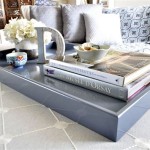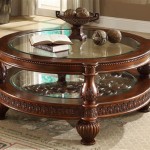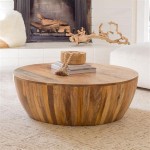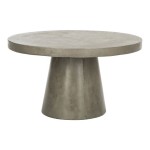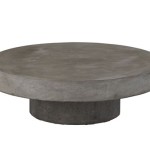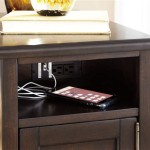What Is The Standard Height of an End Table?
End tables, ubiquitous in living rooms, bedrooms, and even offices, serve as crucial surfaces for lamps, drinks, books, and a myriad of other items. Their functionality depends significantly on their height, which must be appropriate to the seating or furniture they accompany. Determining the "standard" height of an end table involves understanding the various applications, the types of furniture they are typically paired with, and the ergonomic considerations that inform comfortable use.
The concept of a "standard" height can be somewhat misleading, as there isn't a universally fixed measurement. Instead, the ideal height is relative and depends on the context in which the end table will be used. However, general guidelines and common ranges exist to help individuals select the most appropriate end table for their needs. This analysis will explore these guidelines, focusing on different room settings and functional purposes.
End Tables in Living Rooms: Considerations for Sofa and Chair Height
In living rooms, end tables are most commonly positioned next to sofas and armchairs. The primary function here is to provide a convenient surface within easy reach for placing beverages, remote controls, or reading materials. Therefore, the height of the end table should be closely aligned with the height of the sofa or chair arm. As a general rule, the surface of the end table should be approximately level with, or slightly lower than, the arm of the adjacent seating. This ensures that the user can easily reach items on the table without straining.
Typical sofa arm heights range from 24 to 32 inches. Consequently, end tables intended for use alongside sofas often fall within this height range. A table that is too low will require the user to lean down uncomfortably to access items, while a table that is too high will make it awkward to place items down and create a visually unbalanced aesthetic. A difference of a few inches, either above or below the arm height, is generally acceptable, but a significant discrepancy should be avoided.
Armchairs, while similar in function to sofas, can vary more significantly in height. Some armchairs have lower, more relaxed profiles, while others are more upright and formal. When selecting an end table for an armchair, it's essential to measure the arm height specifically. The same principle applies: the end table surface should be roughly level with, or slightly below, the arm. In some cases, a slightly taller end table – perhaps an inch or two above the arm height – might be preferable, particularly if the table is also intended to hold a lamp. This extra height can help position the lampshade at a desirable level for reading light.
The style of the sofa or armchair also influences the choice of end table height. A modern, low-slung sofa might pair well with a minimalist end table that is also relatively low in profile. Conversely, a more traditional, high-backed armchair might require a taller, more substantial end table to maintain visual balance. Consideration of the design aesthetic is crucial to ensure the end table complements, rather than clashes with, the surrounding furniture.
The function of the end table further dictates the ideal height. If the end table is primarily intended for holding a lamp and a few decorative items, a slightly taller table might be acceptable, even if it exceeds the arm height of the sofa or chair. However, if the primary function is to provide a surface for drinks or snacks, the height should be carefully matched to the seating height for optimal convenience.
End Tables in Bedrooms: Height Considerations for Bedside Tables
In bedrooms, end tables serve a different purpose, primarily functioning as bedside tables. Their main role is to provide a surface for lamps, alarm clocks, books, and other necessities within easy reach of the bed. Consequently, the ideal height of a bedside table is closely related to the height of the mattress and the overall height of the bed frame.
As a general guideline, the surface of the bedside table should be approximately level with, or slightly above, the top of the mattress. This ensures that the user can easily reach items on the table while lying in bed. A table that is too low will require the user to sit up and reach down uncomfortably, while a table that is too high will make it awkward to reach items without bumping into the table.
The standard mattress height, including the bed frame, typically ranges from 25 to 30 inches. Therefore, bedside tables often fall within this height range. However, mattress heights can vary significantly, particularly with the increasing popularity of thicker mattresses and platform beds. It is crucial to measure the height of the mattress from the floor to determine the optimal bedside table height. A difference of a few inches, either above or below the mattress height, is generally acceptable, but a significant discrepancy should be avoided.
For beds with very high mattresses, such as those with pillow tops or memory foam, a taller bedside table might be necessary. In these cases, the table height could exceed 30 inches. Conversely, for beds with lower profiles, a shorter bedside table might be more appropriate. The visual balance between the bed and the bedside table is also important. A table that is disproportionately tall or short will appear visually jarring.
Beyond height, the depth and width of the bedside table should also be considered. A larger bedside table can provide more surface area for multiple items, but it should not be so large that it overwhelms the space or obstructs movement around the bed. The style of the bed also influences the choice of bedside table. A modern bed with clean lines might pair well with a minimalist bedside table, while a more traditional bed might require a more ornate bedside table.
Beyond Standard Heights: Alternative End Table Types and Functions
While standard height ranges exist for end tables in living rooms and bedrooms, a variety of alternative end table types cater to specific needs and aesthetic preferences. These include drum tables, pedestal tables, nesting tables, and C-tables, each offering unique height and functional characteristics.
Drum tables, characterized by their cylindrical shape, often have a consistent height that aligns with typical sofa arm heights, making them suitable for use in living rooms. Pedestal tables, with a central support base, can vary significantly in height, allowing for greater flexibility in placement and function. These tables can be adjusted to match the height of specific chairs or sofas or used as standalone accent pieces.
Nesting tables, consisting of a set of tables that fit within each other, offer versatility and space-saving benefits. The heights of nesting tables are typically graduated, allowing them to be used individually or grouped together to create a larger surface area. When choosing nesting tables, the height of the tallest table should be considered in relation to the surrounding furniture.
C-tables, named for their C-shaped design, are specifically designed to slide under sofas or chairs, providing a convenient surface for laptops, snacks, or drinks. These tables are often slightly taller than the seating to ensure that the surface is easily accessible. The height of a C-table should be carefully considered to ensure that it comfortably fits under the furniture and provides a stable surface.
Beyond these alternative types, adjustable-height end tables offer the greatest flexibility. These tables allow the user to customize the height to match their specific needs and preferences. Adjustable-height end tables are particularly useful in spaces where multiple people with varying needs will be using the table. They can also be adjusted to accommodate different activities, such as reading, writing, or eating.
Ultimately, the "standard" height of an end table is a relative concept that depends on the specific context, the type of furniture it will be paired with, and the intended function. By carefully considering these factors, individuals can select the most appropriate end table to enhance the comfort and functionality of their living spaces.

End Table Heights

End Table Heights

End Table Height How Tall Should Your Side Be Ca Tables

Nill Fremont Nightstand Oak Walnut Furniture

Height Of A Sofa Table Ashley Furniture Home Office Coffee Measurements Size

Wooden Sofa Side Table With Wheels And Storage For Hospital Residential 6 At Rs 1700 In Mumbai

Convenience Concepts Mission 15 75 In Gray Standard Height Square Wood Top End Table With Shelves S20 250 The Home Depot

Considering Scale Elegant Bedside Tables Table Lamps

Study Table Dimensions Free Dwg Layakarchitect

Standard Sofa Table Height Home Office Furniture Desk Check More At Http Www Nikkitsfun Com S Coffee Size Dimensions
Related Posts

